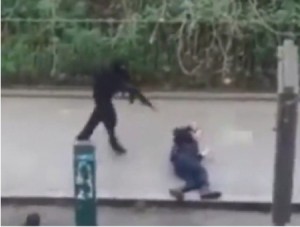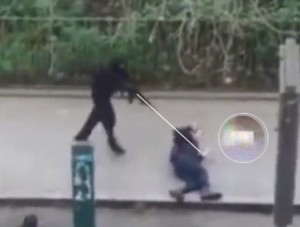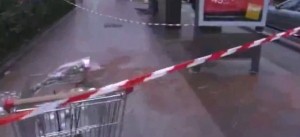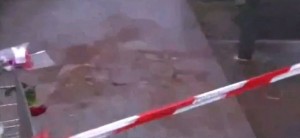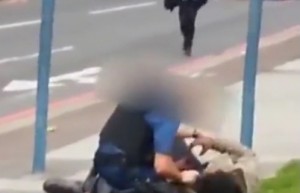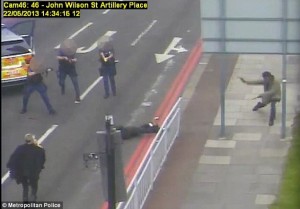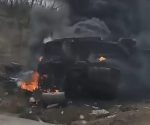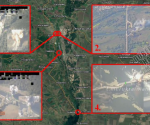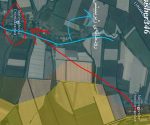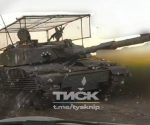Charlie Hebdo shooter appears to fire a blank round – echoes of Woolwich detected
Footage showing the moment that the two men said to be the Charlie Hebdo assailants leaving their vehicle to shoot down a policeman in the Paris street of Boulevard Richard-Lenoir is being called out by internet researchers as containing an anomaly that undermines the official narrative. It is being claimed that the fatal shot to the head supposedly suffered by Ahmed Merabet was in fact a blank round which was also fired away from the so-called target to avoid injury or death from the ejected plug material. The video begs this question: if the masked men shown in the video had weapons loaded with blanks, how could they have been the same perpetrators who, with live ammunition, had killed 11 people in the initial assault? The possibility that suggests itself is that this subsequent event was a dioramic emulation to create a visual for public consumption so as to reinforce the danger and reality of an event that otherwise took place essentially behind closed doors and beyond general experience – unlike the Woolwich so-called terror incident which had numerous witnesses to it. In turn this would raise entirely new questions about the spontaneity of the attack, and who exactly was involved in its organisation or at least its facilitation. Internet researchers, and some alternative media, are already suspecting the entire incident to be a false flag attack (here is one of the more measured investigations), but this article will limit itself to examining the content of the police-shooting video and some immediately peripheral issues. The reader will note that Woolwich has been mentioned, and this article will also briefly discuss an issue in common. As the Woolwich event insists on being a fabricated sham after any honest scrutiny is applied to it, this connection could be a valuable indicator as to the nature of the Charlie Hebdo episode.
The images labelled Figures 1 and 2 are two versions of the same frame-segment from the video in question (click on each to enlarge). Figure 1 is the unadulterated original, while Figure 2 is one to which two enhancements have been added. Firstly a line has been drawn that extends the barrel of the weapon held by the policeman’s so-called executioner down onto a point which is adjudged to be at ground level. The second alteration is the application of different contrast levels within the circled area of the image. This area shows what must be the ejected material from the firing of the weapon – the manipulation is merely to bring about more clarity. It should be made entirely clear that this is the moment that the fatal bullet was supposedly fired. We know this because before this moment, Ahmed Merabet had been writhing around on the floor, and even talking to his assailant (this “fact” and others have been collated on a Wikipedia page). After this moment, Merabet ceased moving, and his assailants withdrew from the area without firing their weapons again.
As the reader will probably know, a blank round can be plugged with material that decomposes or disintegrates after it has been fired – although at close range it can still be compact enough to cause serious injury and even kill. Any weapon will also expel propellant gasses which are forced through the barrel behind the path of the bullet, or in the case of a round, the plug material. The combined material in the latter of those cases is very likely what the cloud in the image is comprised of (although it could just be gas). The line of the rifle indicates that the shot was fired behind the shoulders of the policeman, and definitely not at his head. Moreover, the cloud seems to be blooming further towards the camera position than the policeman’s shoulders, with a tail leading to the left and the ground. Overall the composition suggests that the emission from the weapon has bounced off the pavement, having been fired from behind and towards the policeman, to then travel in front and away from him.
Further argument against the firing of a live round rests in two pieces of visual evidence. The first is to do with the policeman’s physical reaction to the bullet – supposing it had hit him, of course. For one thing, he does not react violently to the shot – it was if any bullet had entered him like a hot knife cuts butter. There is also no blood to be seen – neither immediately in terms of splatter from the penetration of the bullet, or gradually in a flow onto the pavement from the wound (we shouldn’t have to wait too long to see this happen). Secondly, the round does no discernable damage to the pavement. Certain internet researchers who are au fait with ballistics have remarked that the live round from an AK-47 should have caused a chunk of paving material to have been displaced. The author thinks that this might indeed be the case if the bullet had missed its target, but otherwise he imagines any intervening flesh to be capable of absorbing quite a lot of the bullet’s energy and is not sure about this assertion.
The issue of the blood – or the lack of it – takes a curious turn when it is pursued further. In a SKY news report in the aftermath of the shooting, reporter Ian Woods does a piece to camera in front of the spot where Ahmed Merabet was supposedly gunned down (see the video here). At one point the camera shot zooms in on a cordoned-off area – which nevertheless contains memorial objects (one of them a shopping trolley, bizarrely enough) demonstrating that people have felt at liberty to trapse in and out in order to deposit their offering – to show the floor covered in blood (see Figs 3 & 4).
Woods makes a point of telling his viewers that it is the blood of the policeman who had been shot at this location. However, there is a problem. The centre of what is discernibly the main collection of blood is out of position. The shooting footage shows that when shot dead (supposedly), Merabet was centrally placed between what looks like a parking ticket dispenser and an electronic advertising bill board. However, the blood in Woods’ report is concentrated in a place much nearer the latter of those two pieces of street furniture. In fact, if a line perpendicular to the kerb is drawn that intercepts the supporting pole of that sign, it would also intersect the central coagulation of blood. Of course, where this matter is most dense is logically the nearest it could be to the body on bleeding out – it would be less dense the further it drained away. The blood on the crime scene does not support the video if the video is supposed to represent a definitive account of how Merabet died [a good opportunity to state that no claim is being made here that Merabet is not dead – instead it is being noted that he appears not to have been killed in the way we are being told].
Ian Woods’ account of this blood pool also threw up some completely avoidable controversy – what we might call a red rag to a conspiracy theorist bull. He said the following:
You can see the blood on the ground which has been put there to… because of the blood that was shed on this spot, err, yesterday.
Some may call this mere clumsiness. Others might call it the evidence of some psychological trauma caused by having to tell what the mind knows is not the truth and can never be rationalised as such – a Freudian slip might be too much of a simplification. It’s the author’s view that to describe bleeding out of the body as “putting on the ground” would be quite a feat for someone who was really under no illusion that there could be no other cause for the presence of the material than a corpse that had been killed on the spot.
Back in May 2013, it was also the problem of blood – or the lack of it (or even if it had appeared in the right place at the right time) – that provoked researchers to be immediately suspicious of the supposed Woolwich terror attack, and left them wide open to being debunked. So this is not the issue by which we will link the two incidents – the focus has after all been on the evidence of the use of a blank bullet that contradicted an official claim that a live round was used.
Not long after the Woolwich incident it emerged that Michael Adebowale had somehow been injured in the hand during his encounter with arresting police. During his trial the state of affairs was stated as absolute fact. The following is the reportage from the MailOnline:
The officer then turned his attention to Adebowale, who was lying on the ground after being shot by one of his colleagues.
‘He raised one of his arms up,’ E48 said. ‘I’ve still got a distinct image in my mind of him holding a black revolver in his hand which I clearly saw, which struck me as unusual because he’d just been shot.
‘The next two shots shot his thumb off [on the] hand holding the weapon.’
Once both the terror suspects posed no further threat, E48 used a first aid kit from the police car to treat Adebowale.
He added: ‘Once the threat is neutralised we have a duty of care to all persons to save life, no matter who they are.’
However, when we examine the footage of the rendering of that mentioned first aid, there is a moment when the blurring fails and Adebowale’s right hand (the one that had been pointing the firearm – see Figure 6) is revealed in its entirety – meaning exactly that. As Figure 5 shows, Adebowale had a thumb when he was arrested – which suggests that the police and the two perpetrators where engaged that day in an elaborate piece of theatre where Adebowale and Adebolajo acted as if they had been hit by gunshots, and the police acted as if they had administered them. It’s another thing altogether to prove to what extent the whole event was a charade, but what Adebowale’s thumb does show us is that his “exchange” with gun-toting police was for creating a psychological effect on a public who would see the event on their TV. If no evidence could ever thereafter be produced by police that could have convicted Adebowale and Adebolajo of murdering Lee Rigby, it wouldn’t have mattered because they were already guilty due to their very public battle with police. Moreover, because the two Michaels must have conspired with the authorities to put on the drama of a shoot-out, we cannot escape the fact that it must have been conceived by people who had power over certain police, who controlled the two perpetrators, and had access to other means and resources so as to be able to execute such a complex psychological operation.
When we apply these revalations to Paris, it perhaps makes sense as to why it was that the two gun men effectively returned to the scene of the crime to commit the killing of Merabet (according to Ian Woods at least). Doubling back on themselves while making their getaway, the two perpetrators just happened to come across the policeman and, even though they must have known they had stirred up a hornet’s nest, chose to get out of their vehicle to make a dramatic example of him – all conveniently in front of a ready-placed and waiting camera operative. The situation smacks of an operation of the ilk perpetrated in Woolwich – and the secondary police encounter involving weapons seems less of a coincidence and more of a script requirement.




